Spatial and Physiological Ecology of Spotted Turtles (Clemmys guttata) in Industrialized Northwestern Indiana
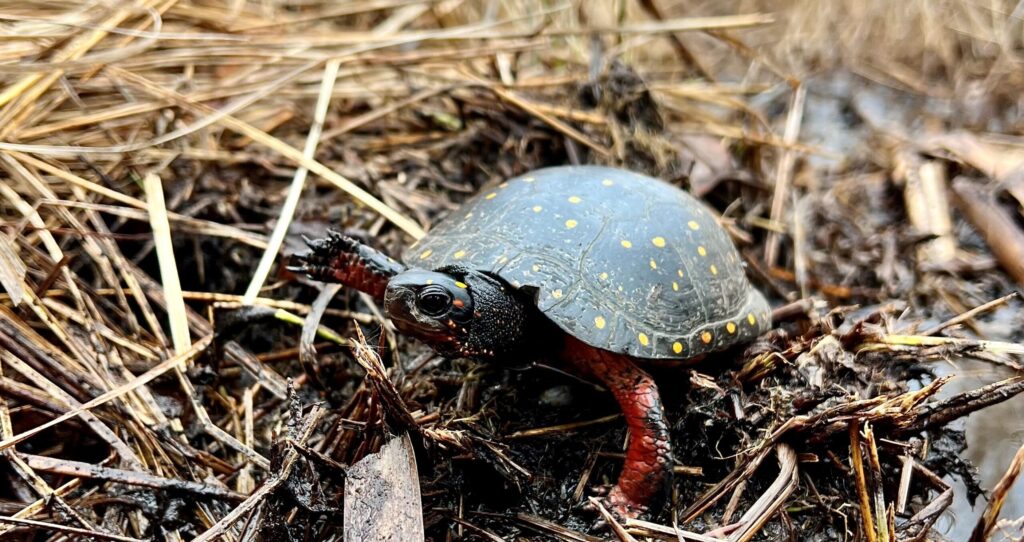
Spotted turtles (Clemmys guttata) are an Indiana State Endangered turtle and a national Species of Concern (currently a candidate for higher status). This small, semi-aquatic omnivore uses a variety of freshwater areas including marshes, bogs, ephemeral wetlands, and upland terrestrial habitat. Northwestern Indiana underwent rapid industrialization and urbanization since the late 19th Century and these changes have led to drainage, filling, and industrial pollution of regional aquatic ecosystems. The Harden Lab and the Milanovich Lab are investigating 1) the spatial and seasonal ecology and 2) physiological ecology of two populations of spotted turtles inhabiting sites adjacent to industrialized Northwest Indiana.
Investigating the Health of Lake St. Benedict via Biotic and Abiotic Surveys
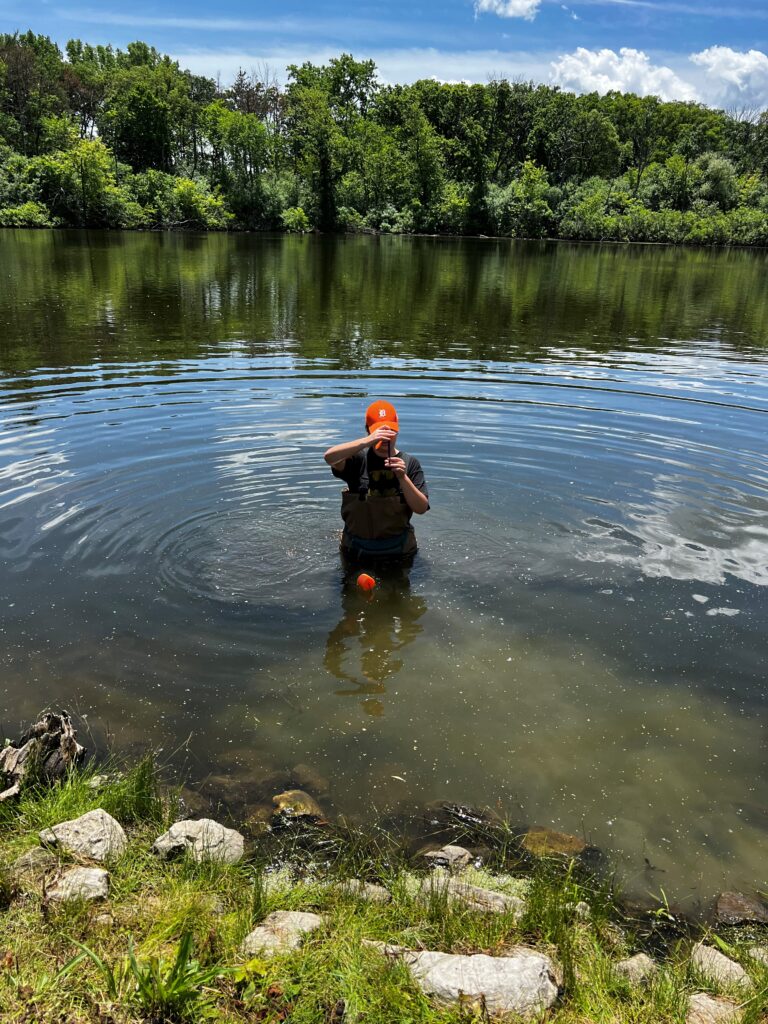
Suburban freshwater ecosystems are susceptible to eutrophication – the process of excess nutrients causing rapid algal growth, ultimately depleting the water of oxygen required for aquatic life. Water chemistry and sediment surveys indicate the shallow, suburban lake on BenU’s campus (Lisle, IL) has an excess of phosphates, leading to eutrophic conditions during the summer months. Various lake treatments of algaecides and soluble phosphorus removing product (Phoslock, Eutrosorb) are currently used to reduce the algal growth and aquatic phosphate levels, with the goal of reducing harmful algal blooms and deadly hypoxic conditions. The Harden Lab is investigating the aquatic health of a shallow, eutrophic, regularly-treated, suburban lake (Lake St. Benedict) using biotic (macroinvertebrate diversity) and abiotic (water chemistry) ecosystem indicators.
Turtle Population Ecology on the Benedictine University Lisle Campus
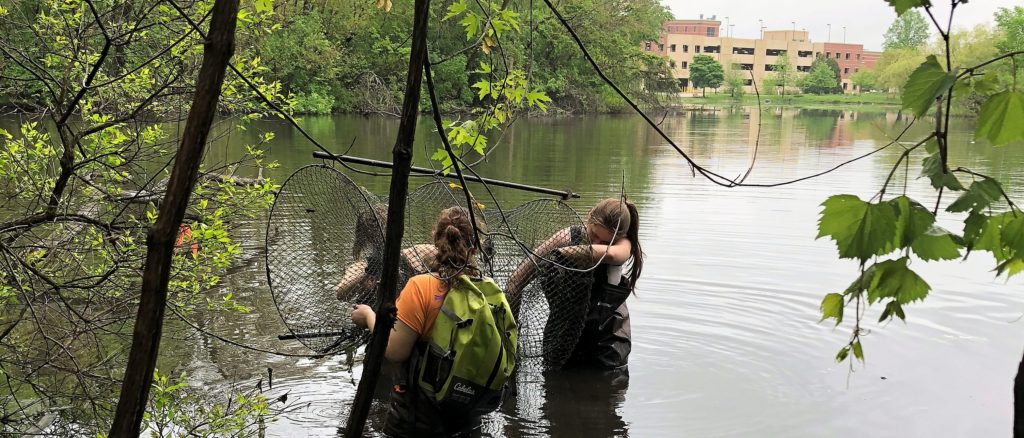
The Harden Lab established a long-term monitoring program in 2018 to document aquatic wildlife inhabiting the Benedictine University campus. The man-made ponds and lakes on campus are home to several reptile and amphibian species, but the population demographics, health and survivorship, and general ecology of these species, in addition to their how they use their suburban environment has not been studied. A herpetofaunal inventory on campus primarily includes an assessment the population ecology of aquatic pond turtles in the water bodies on campus via aquatic trapping and spatial capture-mark-recapture robust sampling approach. This research aims to provide students with the opportunity to develop and test foundational scientific questions about local ecology. Furthermore this research project will educate and raise awareness of the herpetofaunal species on campus and in the greater community.
Population ecology of copperbelly water snakes (Nerodia erythrogaster neglecta) in northern Indiana
The Harden Lab, the Milanovich Lab, and Cardno Environmental (Brock Struecker, M.S.) are conducting research on the endangered coppperbelly water snake across multiple historic wetland locations along a rural, suburban and natural landscape gradient. The objectives of this IN DNR USFWS-funded two year project (2021-2022) are to (1) use recent advancements of population monitoring techniques and frameworks for aquatic snakes to quantify the presence/absence, and potentially population demographics, occupancy, detection probabilities, and effort required to determine presence/absence of the species, and (2) use the proposed survey framework and techniques to gain information on Blanding’s turtle, spotted turtle, and eastern massasaugas populations across the region.
Evaluating the health and physiology of threatened Blanding’s turtles
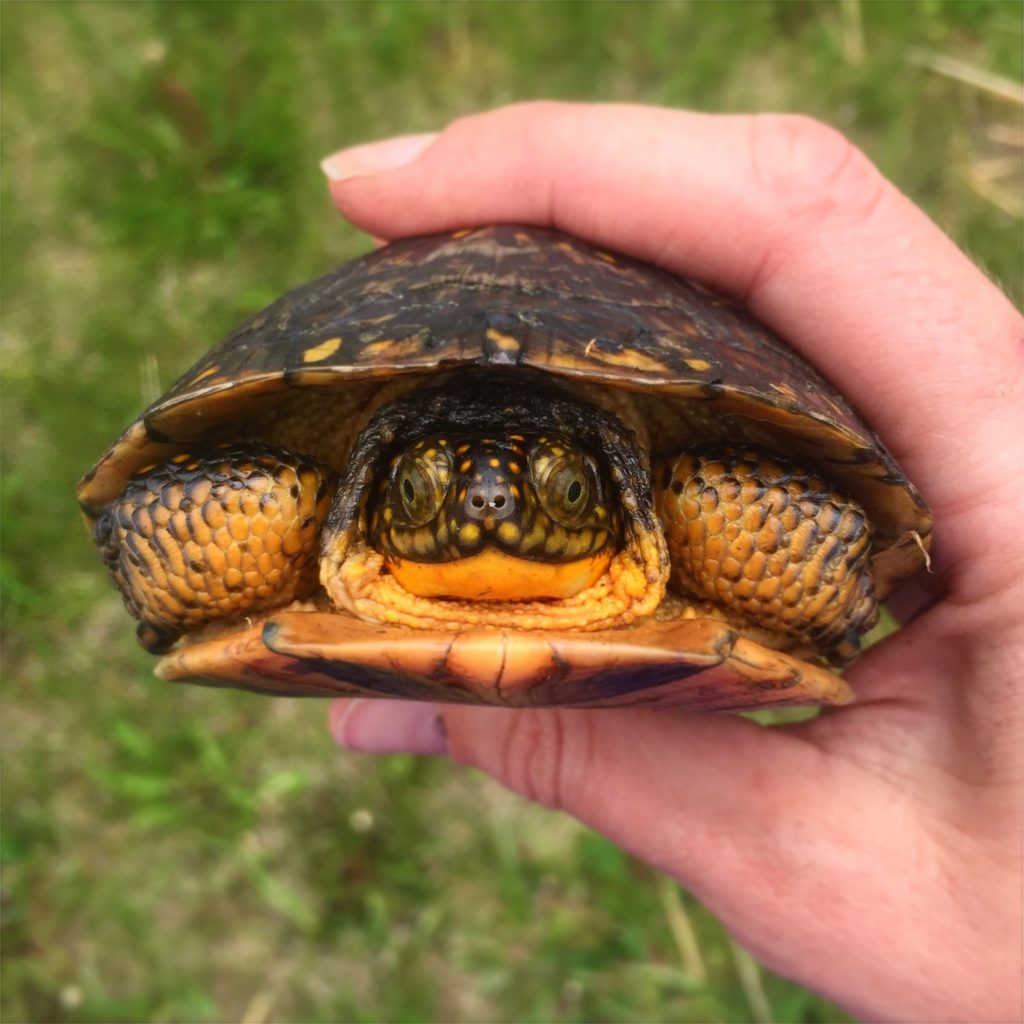 The Harden Lab and the Milanovich Lab are conducting research on the physiological health of captive-reared hatchling and juvenile endangered Blanding’s turtles at captive-rearing programs in the Midwest. This research on the physiology and stress levels of Blanding’s will contribute to the gap in knowledge concerning the effects of captive-rearing efforts on their health and survival and allow for better recommendations regarding captive-rearing procedures. The Harden Lab also investigated Hg levels in gravid female Blanding’s using claw tissue (Publication 1). We are currently collaborating with and educating regional stakeholders on potential long-term impacts of head-starting and translocation programs. Read about the Harden Lab in the Benedictine University’s Spring 2017 magazine Voices, The Daily Herald: Blanding’s turtles get a boost in DuPage, or NCTV17: Forest Preserve Releases Endangered Turtles.
The Harden Lab and the Milanovich Lab are conducting research on the physiological health of captive-reared hatchling and juvenile endangered Blanding’s turtles at captive-rearing programs in the Midwest. This research on the physiology and stress levels of Blanding’s will contribute to the gap in knowledge concerning the effects of captive-rearing efforts on their health and survival and allow for better recommendations regarding captive-rearing procedures. The Harden Lab also investigated Hg levels in gravid female Blanding’s using claw tissue (Publication 1). We are currently collaborating with and educating regional stakeholders on potential long-term impacts of head-starting and translocation programs. Read about the Harden Lab in the Benedictine University’s Spring 2017 magazine Voices, The Daily Herald: Blanding’s turtles get a boost in DuPage, or NCTV17: Forest Preserve Releases Endangered Turtles.
Examining the ecology and physiology of Ornate box turtles in northern Illinois
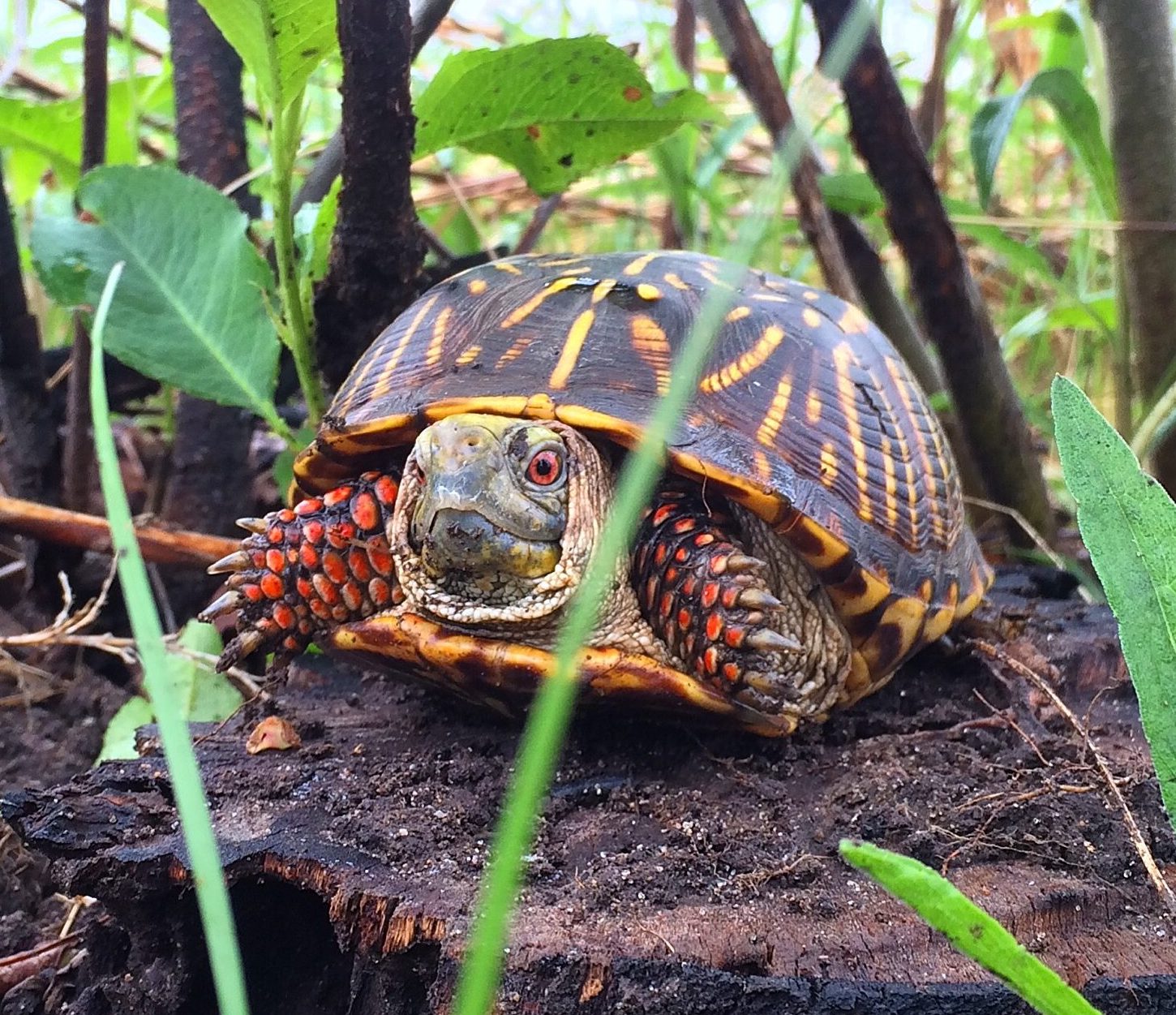 With funding from the Illinois Department of Natural Resources, the Harden Lab is collaborating with the Milanovich Lab @ LUC to examine the characteristics of hibernaculum (Publication 1), home range sizes, blood chemistry (Publication 2), and stable isotopes of ornate box turtles (Terrapene ornata) at three sites in northern Illinois. This work involves several undergraduates and graduate students at LUC.
With funding from the Illinois Department of Natural Resources, the Harden Lab is collaborating with the Milanovich Lab @ LUC to examine the characteristics of hibernaculum (Publication 1), home range sizes, blood chemistry (Publication 2), and stable isotopes of ornate box turtles (Terrapene ornata) at three sites in northern Illinois. This work involves several undergraduates and graduate students at LUC.
Physiological ecology of diamondback terrapins
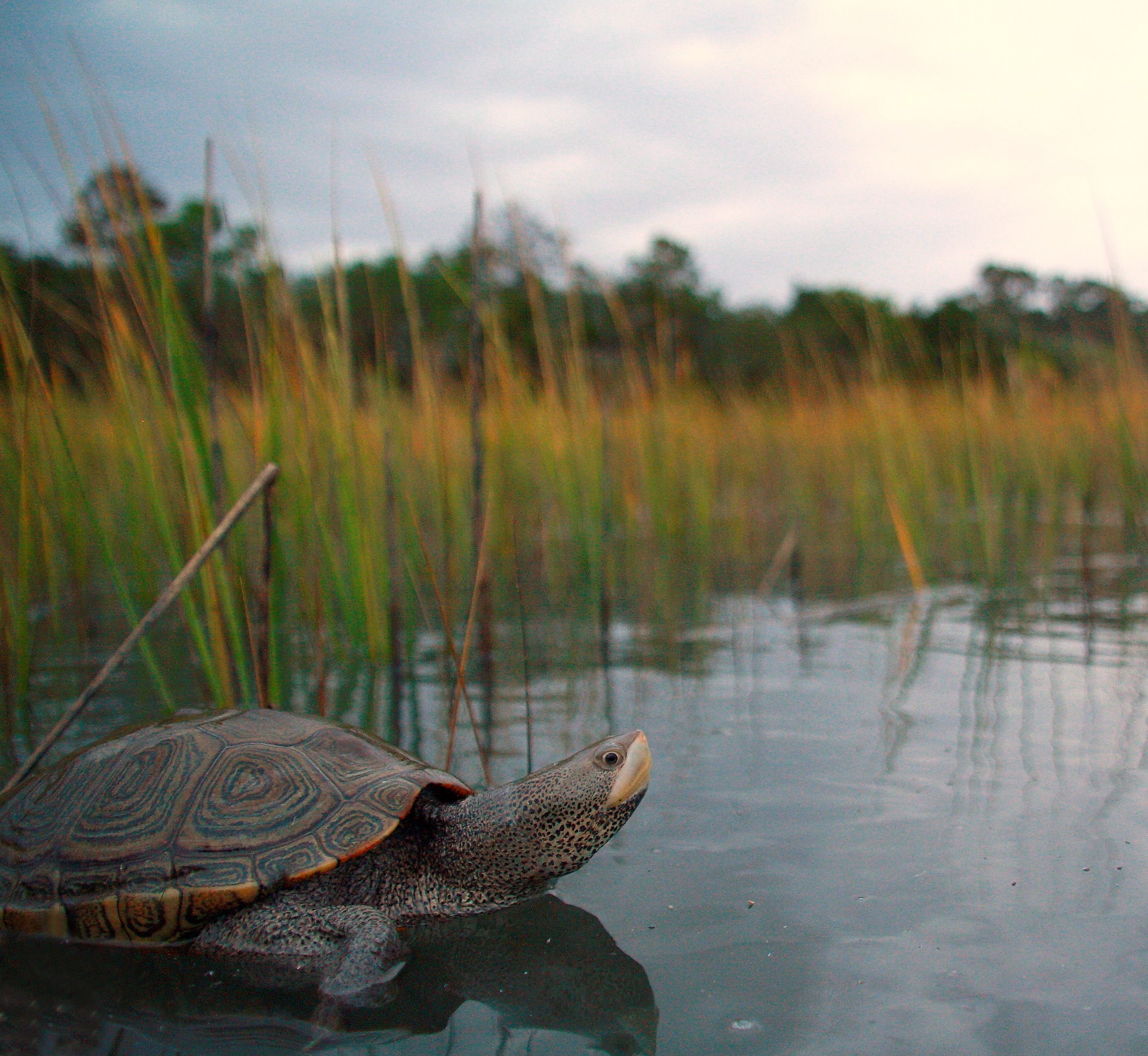 In Collaboration with Dr. Amanda Southwood Williard, Dr. Harden is investigating the behavioral and physiological mechanisms that allow diamondback terrapins (Malaclemys terrapin) to inhabit a dynamic coastal ecosystem. These studies have provided insight into the terrapin’s ability to maintain osmotic homeostasis while experiencing shifts in behavioral and environmental conditions. Further, they shed light on the relative importance of behavioral and physiological adjustments that may have served as pivotal evolutionary steps in the freshwater chelonian invasion of marine environments (Publication 1, Publication 2, Publication 3). Laboratory-controlled osmoregulation and energy metabolism studies of terrapins are ongoing with colleagues Amanda Southwood Williard @ UNCW and Dr. Stephen Midway @ LSU. (photo credit: Jackie Guzy).
In Collaboration with Dr. Amanda Southwood Williard, Dr. Harden is investigating the behavioral and physiological mechanisms that allow diamondback terrapins (Malaclemys terrapin) to inhabit a dynamic coastal ecosystem. These studies have provided insight into the terrapin’s ability to maintain osmotic homeostasis while experiencing shifts in behavioral and environmental conditions. Further, they shed light on the relative importance of behavioral and physiological adjustments that may have served as pivotal evolutionary steps in the freshwater chelonian invasion of marine environments (Publication 1, Publication 2, Publication 3). Laboratory-controlled osmoregulation and energy metabolism studies of terrapins are ongoing with colleagues Amanda Southwood Williard @ UNCW and Dr. Stephen Midway @ LSU. (photo credit: Jackie Guzy).
Spatial and temporal overlap of terrapins and the blue crab fishery
 In Collaboration with Dr. Amanda Southwood Williard, Dr. Harden investigated the seasonal changes in diamondback terrapin activity and habitat use as it related to potential spatial and temporal overlap with the blue crab fishery – a source of terrapin bycatch and subsequent population declines along the US coast. To assess spatial overlap and resulting bycatch risk (BR), seasonal distributions and densities of crab pots and terrapins were calculated and incorporated into a spatial overlap index model modified to include the seasonal aquatic behavior of terrapins. This behaviorally modified model may be applied to other geographic areas to identify areas and times of bycatch risk between fisheries and non-target species (Publication 1). Check out this Coastwatch article: Mapping the Overlap: Terrapins & Crab Pots in the Lower Cape Fear Region, this North Carolina Coastal Federation article: Looking for Answers to Help Terrapins, or this 2013 StarNews newspaper article: Diamondback terrapins subject of UNCW student’s research.
In Collaboration with Dr. Amanda Southwood Williard, Dr. Harden investigated the seasonal changes in diamondback terrapin activity and habitat use as it related to potential spatial and temporal overlap with the blue crab fishery – a source of terrapin bycatch and subsequent population declines along the US coast. To assess spatial overlap and resulting bycatch risk (BR), seasonal distributions and densities of crab pots and terrapins were calculated and incorporated into a spatial overlap index model modified to include the seasonal aquatic behavior of terrapins. This behaviorally modified model may be applied to other geographic areas to identify areas and times of bycatch risk between fisheries and non-target species (Publication 1). Check out this Coastwatch article: Mapping the Overlap: Terrapins & Crab Pots in the Lower Cape Fear Region, this North Carolina Coastal Federation article: Looking for Answers to Help Terrapins, or this 2013 StarNews newspaper article: Diamondback terrapins subject of UNCW student’s research.
Population and reproductive biology of spotted salamanders
 Dr. Harden and Dr. Shannon Pittman coordinated several research projects with Davidson undergraduates on spotted salamanders at an isolated wildlife refuge wetland. We investigated various topics such as 1) the development and evaluation of individual identification methods for spotted salamanders (Publication 1), and 2) the influence of sex and migration behavior on reproduction cost of spotted salamanders (Publication 2).
Dr. Harden and Dr. Shannon Pittman coordinated several research projects with Davidson undergraduates on spotted salamanders at an isolated wildlife refuge wetland. We investigated various topics such as 1) the development and evaluation of individual identification methods for spotted salamanders (Publication 1), and 2) the influence of sex and migration behavior on reproduction cost of spotted salamanders (Publication 2).
Mud turtle habitat selection in a modified landscape
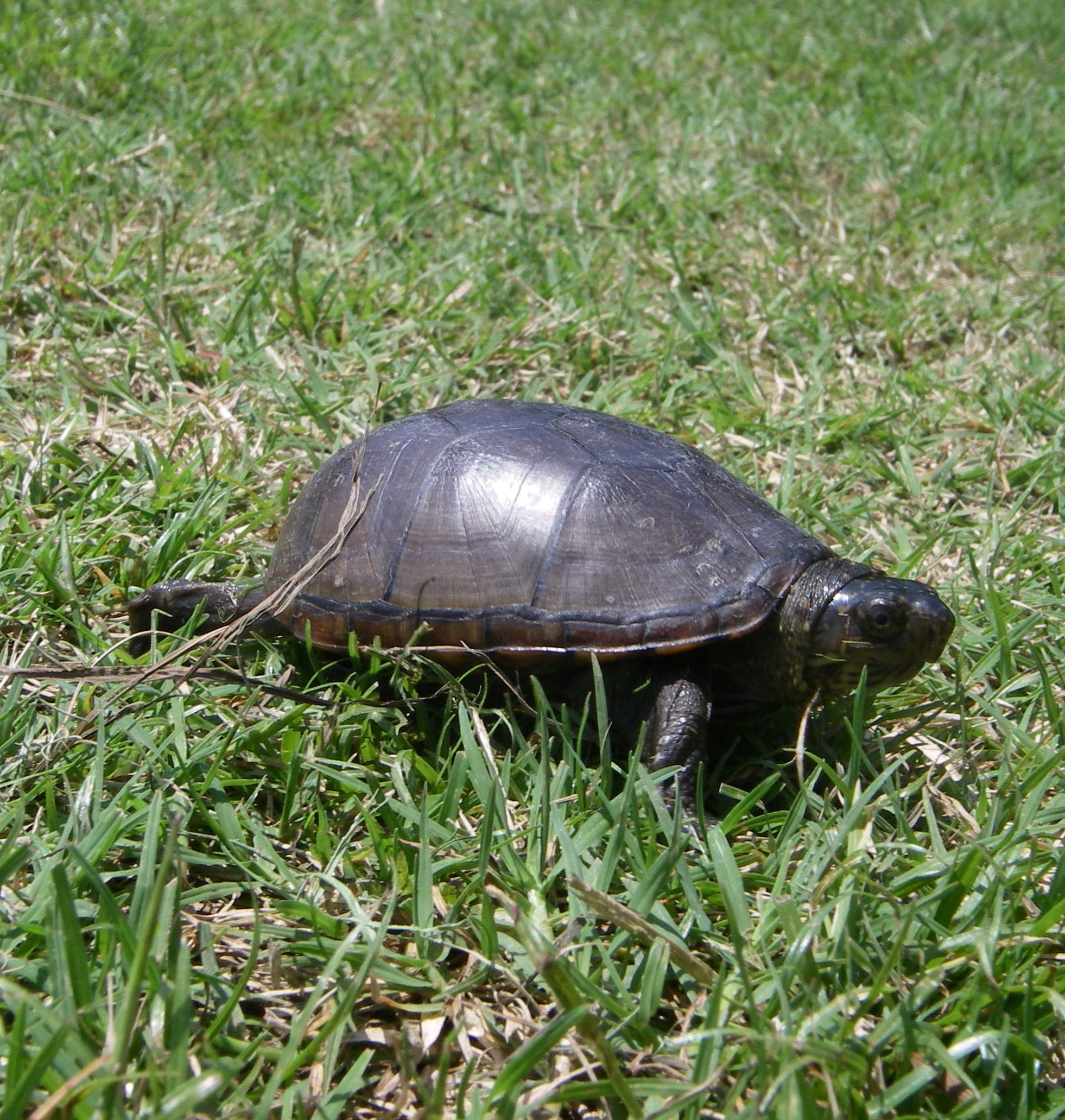 At Davidson College Dr. Harden conducted a radio-telemetry study of semi-aquatic eastern mud turtles inhabiting a golf course pond to investigate their terrestrial activity and habitat selection (Publication 1), and thermal ecology (Publication 2). Information from this study allows for a better understanding of critical upland habitat requirements of other semi-aquatic species and can aid in developing golf course land management plans. Check out the Charlotte Observer article about this turtle research on a golf course.
At Davidson College Dr. Harden conducted a radio-telemetry study of semi-aquatic eastern mud turtles inhabiting a golf course pond to investigate their terrestrial activity and habitat selection (Publication 1), and thermal ecology (Publication 2). Information from this study allows for a better understanding of critical upland habitat requirements of other semi-aquatic species and can aid in developing golf course land management plans. Check out the Charlotte Observer article about this turtle research on a golf course.
